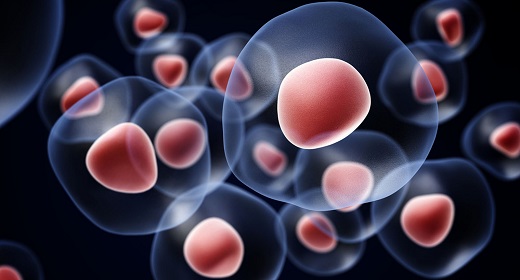by Dr. Andrew Weil: It’s not often that one finds a perfect oxymoron, but it happened to me in a supermarket recently when I encountered a pint of “Fat-Free Half & Half.” In the U.S., half-and-half is typically half milk and half cream and contains about 12 percent fat, so how can such a product be rendered fat-free? Answer: by replacing butterfat (a mostly saturated fat) with corn syrup and adding chemicals and thickeners to simulate fat’s texture and mouth-feel. The ingredients list: skim milk, corn syrup, cream (this is accompanied by a footnote reassuring the consumer that the cream adds “a trivial amount of fat” — I assume because the product contains a trivial amount of cream) and “less than 0.5 percent of the following: Carrageenan, Sodium Citrate, Dipotassium Phosphate, Mono and Diglycerides, Vitamin A Palmitate, Color Added (Ingredient not in regular half-and-half).”
In the U.S., half-and-half is typically half milk and half cream and contains about 12 percent fat, so how can such a product be rendered fat-free? Answer: by replacing butterfat (a mostly saturated fat) with corn syrup and adding chemicals and thickeners to simulate fat’s texture and mouth-feel. The ingredients list: skim milk, corn syrup, cream (this is accompanied by a footnote reassuring the consumer that the cream adds “a trivial amount of fat” — I assume because the product contains a trivial amount of cream) and “less than 0.5 percent of the following: Carrageenan, Sodium Citrate, Dipotassium Phosphate, Mono and Diglycerides, Vitamin A Palmitate, Color Added (Ingredient not in regular half-and-half).”
Odd as fat-free half-and-half may seem, it’s far from unique. A search for the term “fat-free” in the grocery section on Amazon brings up 3,386 products; “low-fat” yields 3,597. That’s a vast array of food products in which no- or low-fat content is touted as a virtue. Many of them, like the pseudo half-and-half, compensate for the fat’s absence with extra sugar, corn syrup or other added sweeteners.
Such products are so ubiquitous that it’s easy to forget just how new they are. From 1958 to 1970, nutrition researcher Ancel Keys surveyed populations in seven countries then published a study suggesting a strong correlation between diets high in saturated fat and increased risk of heart disease. The study was controversial from the start, and its methodology has since been criticized by many (had Keys used available information from 22 countries, rather than the seven he chose, no correlation would have been seen, leading to charges that his data set was “cherry-picked”). But by 1977, the Senate’s Select Committee on Nutrition and Human Needs went all in. Its “Dietary Goals for the United States” perfectly reflected Key’s dodgy findings, urging Americans to eat less fat and more grains.
The notion went mainstream when an avalanche of supermarket products engineered along these lines soon followed. The reason? Pure profit. Relative to fats, commodity grains and grain-based products such as high-fructose corn syrup are cheap to produce, especially when they are subsidized. This allows breathtaking profits for food processors. Consider some prices taken from the commodity indexes on April 26, 2012, and from my local supermarket:
- Commodity corn costs about 10 cents per pound. A brand-name, one-pound bag of corn chips retails for about $4.
- Commodity wheat costs about 11 cents per pound. A brand-name, two-pound loaf of white bread contains about 18 cents worth of wheat and sells for about $3.50.
This fat-is-bad, sugar-and-processed-carbs-are-harmless movement reached the height of absurdity by the late 1990s, when the American Heart Association (AHA) allowed Kellogg’s Frosted Flakes, Fruity Marshmallow Krispies and Low-Fat Pop-Tarts all to receive the AHA’s Seal of Approval.
Fortunately, such nonsense is on the wane. “It’s time to end the low-fat myth,” said Walter Willett, professor of epidemiology and nutrition and chair of the Department of Nutrition at the Harvard School of Public Health:
“Unfortunately, many well-motivated people have been led to believe that all fats are bad and that foods loaded with white flour and sugar are healthy choices. This has clearly contributed to the epidemic of diabetes we are experiencing and premature death for many.”
Evidence is accumulating to bolster that point. For example, in 2009, a systematic review supported by the Heart and Stroke Foundation of Canada of cohort studies and randomized trials concluded that there was “insufficient evidence of association” between saturated fat intake and elevated risk of coronary heart disease. Instead, it singled out the influence of foods with a high glycemic load — that is, sugar- and processed-carbohydrate-laden foods — in raising cardiovascular disease risk.
It’s not just that fat is neutral — the right kinds have some unique health benefits. Another study, published in the Dec. 21, 2010 issue of the Annals of Internal Medicine, showed that a natural substance in dairy fat, trans-palmitoleic acid, may substantially reduce the risk of Type 2 diabetes (and, as result, of heart disease). The research team from the Harvard School of Public Health looked at more than 3,700 men and women age 65 or older in a National Institutes of Health-funded Cardiovascular Health Study who had been followed for 20 years to evaluate risk factors for cardiovascular diseases in older adults. The investigators found that participants who reported eating more whole-fat dairy products had higher levels of trans-palmitoleic acid in their blood. Over the following years those men and women who had the higher levels of trans-palmitoleic acid were about 60 percent less likely to develop diabetes than those whose blood levels of trans-palmitoleic were lowest.
The American public has been led astray, as the government and industry have used shaky science to demonize natural fats and promote fat-free dairy products, processed grains and sweeteners. The fact is that natural fats and fat sources such as extra-virgin olive oil, butter, virgin coconut oil, oily cold-water fish and even an occasional grass-fed, grass-finished steak are all good for you if eaten moderately in the context of a low-glycemic-load diet. They supply essential fatty acids and satiety while helping to keep blood sugar levels, insulin and whole-body inflammation levels appropriately low and steady. Conversely, we all need to stay away from hydrogenated oils and from polyunsaturates including soybean oil, commonly termed “vegetable oil,” which is used for deep-frying and in cheap baked goods. I believe the evidence is clear that these are strongly pro-inflammatory.
No one’s health is improved by swapping out natural saturated or monounsaturated fats for skim milk, sugars or processed grains. So if you encounter misbegotten products such as fat-free half-and-half, do what I do — leave them on the shelf.









































